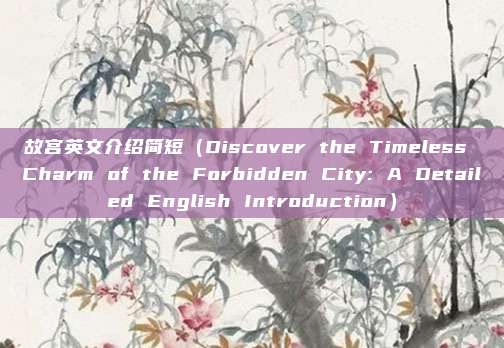故宫英文介绍简短(Discover the Timeless Charm of the Forbidden City: A Detailed English Introduction)
温馨提示:这篇文章已超过301天没有更新,请注意相关的内容是否还可用!
Nestled in the heart of Beijing, the Forbidden City, also known as the Imperial Palace, stands as a testament to ancient Chinese history and architectural prowess. This majestic complex has been the imperial palace of 24 emperors from the Ming and Qing dynasties, and it remains a symbol of China's rich cultural heritage. In this article, we will delve into the fascinating history, architectural wonders, and cultural significance of the Forbidden City, providing you with a comprehensive English introduction.
History of the Forbidden City
The construction of the Forbidden City began in 1406 during the Ming Dynasty and was completed in 1420. It served as the imperial palace for nearly 500 years until the end of the Qing Dynasty in 1912. The name "Forbidden City" is derived from the fact that it was a forbidden area for commoners, and entry was strictly regulated.
The complex covers an area of 720,000 square meters and consists of 980 buildings, all of which were meticulously designed and constructed to reflect the grandeur and authority of the emperors. The Forbidden City was not only a royal residence but also a center of government and religious activities.

Architectural Marvels
The architecture of the Forbidden City is a blend of traditional Chinese styles and is renowned for its harmony, balance, and symmetry. Here are some of the architectural wonders you can explore:
1、The Hall of Supreme Harmony (Taihedian): This is the largest and most important building in the Forbidden City. It was the main hall where emperors held court and conducted state affairs. The hall is surrounded by an expansive courtyard, symbolizing the emperor's authority over the land.
2、The Hall of Central Harmony (Zhonghedian): Located to the north of the Hall of Supreme Harmony, this hall was used for preparing for ceremonies and rituals.
3、The Hall of Preserving Harmony (Shouhedian): Situated to the south of the Hall of Central Harmony, this hall served as a place for the emperor to receive envoys and conduct diplomatic affairs.
4、The Imperial Garden: The garden is a serene retreat within the palace complex, featuring ponds, pavilions, and lush greenery.
Cultural Significance
The Forbidden City is not just a historical site; it is also a repository of cultural treasures. The palace houses an impressive collection of artifacts, including paintings, calligraphy, ceramics, and jewelry. The collection reflects the artistic achievements of ancient China and provides insight into the daily lives of the emperors and their court.
Visiting the Forbidden City
Today, the Forbidden City is a popular tourist destination, attracting millions of visitors each year. To ensure a pleasant visit, here are some tips:
Tickets: Purchase your tickets online or at the entrance. It is recommended to buy tickets in advance, especially during peak tourist seasons.
Guided Tours: Consider joining a guided tour to learn more about the history and significance of the palace. There are various tour options available, including audio guides and guided group tours.
Dress Appropriately: Since the Forbidden City is a sacred place, dress modestly and respectfully.
Photography: Photography is allowed in most areas, but flash photography is prohibited in some exhibitions and galleries.
In conclusion, the Forbidden City is an extraordinary place that offers a glimpse into the past and a profound understanding of ancient Chinese culture. Its architectural beauty, historical significance, and cultural treasures make it a must-visit destination for anyone interested in Chinese history and culture. Whether you are a history buff or simply curious about the grandeur of ancient China, the Forbidden City promises an unforgettable experience.
网站文章、图片来源于网络,以不营利的目的分享经验知识,版权归原作者所有。如有侵权请联系删除!





还没有评论,来说两句吧...